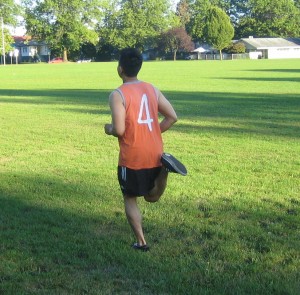A hamstring strain causes a sudden sharp pain that can be felt at the back of the thigh. Athletes playing football, soccer, basketball, runners and also skaters are susceptible to this condition.
A hamstring is a group of 4 muscles found along the back of the thigh which allow bending the leg at the knee. A hamstring strain occurs when one or more of these muscles becomes overloaded and begins to tear when performing activities such as long distance running, sudden stopping and starting as well as jumping.
How To Learn to Recognize and Manage
The material posted on this page is for learning purposes only. Learn to recognize and manage sprains and strains by registering for a first aid course in your region.
Causes of hamstring strain
- Hamstring strains happen in two ways either sprinting-related such as running or stretch-related such as performing gymnastics, martial arts or dancing
- Contusion caused by a direct blow or impact
A severe pain can be felt when performing exercises with a snapping or popping feeling - Problems with the lower back and pelvis
Symptoms
- A severe pain can be felt when performing exercises with a snapping or popping feeling
- Tenderness of the area
- Bruising
- Pain in the back of the thigh and lower buttocks when walking, bending over and straightening the leg.
Treatment
- Take time to rest especially the affected leg. Avoid putting weight on the affected leg. Seek the help of a physical therapist if there is a need to use crutches.
- Apply an ice pack on the affected area to minimize the pain and swelling at least 20-30 minutes every 3-4 hours for 2-3 days until the pain disappears.
- Apply a compression wrap immediately for at least 10-15 minutes every hour on the first day and then every 2-3 hours.
- Wear a compression bandage or thigh support to minimize bleeding in the muscle and lessen the swelling.
- Elevate the affected leg above the level of the heart to lessen swelling and promote drainage of fluid.
- After the initial treatment, a warm and cold compress can be applied alternately on the affected area. Apply heat on the area for at least 20 minutes for increased blood flow in the area and also helps relax the muscles.
- Seek the help of the physical therapist for some rehabilitation exercises such as strengthening, stretching and functional exercises.
- Perform foam roller exercises for the hamstring since it massages and releases shortness and tightness of the muscles.
- Take the prescribed over-the-counter anti-inflammatory pain medications such as ibuprofen or naproxen to lessen the pain and swelling.
Tips
- Warm up is an important measure in preventing strain on the hamstrings. Perform some light aerobic exercises and stretching.
- The flexibility of the hamstring lessens the risk for injury. Tightness of the hamstring is measured by flexing the hip as far as possible by laying flat on the back and raising the leg straight up. The normal range of motion for this exercise is 80 degrees at the hip and less than 80 degrees indicates tight hamstring muscles.
- Wear compression shorts that reduce the risk of injuring the hamstrings since it provides warmth, increase blood flow in the area and support for the muscles.

